I booked UTS 100k soon after running the UTS 50 event last year. The mountaineous terrain in Eryri is very challenging, and the race promises a ‘brutal but beautiful’ experience. Both of those claims were delivered this year with another hot race weekend in the mountains.
Race Profile
The race is 104km in length, with an elevation gain of 6400 meters, summiting a number of big mountains in the region.
Pre-race and Registration
Registration for those running the 100k was first thing on Friday morning, meaning I needed to get to North Wales early on, as well as take the day off work.
I was up at 2:30am and drove up the coast of Pembrokeshire, northward to arrive in Llanberis (where registration and the race start are located) at around 7:30am.




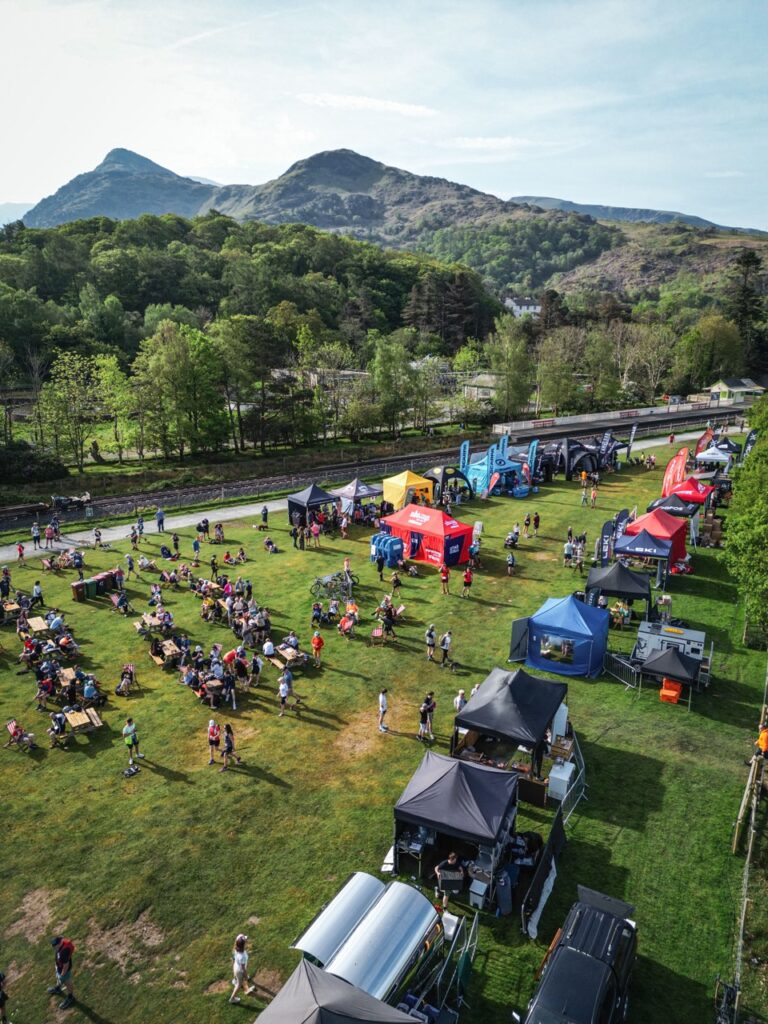
Registration was easy enough. They’ve improved things by giving everyone a tray with pre-marked positions for all mandatory gear to be placed on.
This year’s kit list was bigger than last year’s with more gear required to be taken along with for the 100k compared to the 50k.
I met up with a bunch of friends at registration, including Darren who blogs over at A Runner’s Highs (Darren was taking on UTS 50 this year).
The group photo below is a whole contingency of awesome people who gathered into a group WhatsApp chat weeks ahead of the event (Thanks Hayley for organising this!) We all shared advice, nervous thoughts, strategies, and good banter in the lead up to the race.
This is truely an amazing bunch of like-minded ultra endurance athletes, and all round great people.
I hung around for a while after registration, enjoying some pizza for lunch, before heading back to my campsite I booked for the night, 15 minutes away.
My campsite only cost me £8 for the night, as well as £1 for a shower token. Just as well, because I wouldn’t be sleeping long there. I slept in the back of my car (no bother pitching a tent!) and was in bed by about 9pm.


UTS 100k Race Morning
Race start was at 4:45am for on Saturday morning, being in the first of two waves starting in the 100k.
I was up at 2:15am, with the various watch and phone alarms I had staged to ensure I got up. I had organised everything so I could get ready efficiently. My running pack and gear was ready, water filled, running clothes arranged and good to go.
I got to my parking bright and early, sipping on my water and electrolytes. In my rush to get ready and leave the campsite I had forgotten to eat my breakfast I had prepared. It wasn’t a problem as I had my half-way point drop bag with me, and the rusks (South African snack) in the bag proved to be a suitable breakfast alternative.
A bus from the parking would shuttle us over to the registration and starting area. The coffee vendor was open and I took the opportunity to get my morning caffeine fix in, although it was earlier than usual.


Up until this point I had been very worried about a small issue that had popped up in my left leg on the inner side of my knee. A week or so prior I was doing one-legged hip dips and think I strained a muscle (or tendon) in this area. It had been tender the entire week and still was the morning of the race.
What gave me hope was that it was a sideways movement related part, and running didn’t seem to aggrevate it much.
As the last few minutes to race ticked over the hype and energy amongst everyone built to a peak. Finally we were off, with an initial 1km or so easy tarmac road running through Llanberis and up to the sharp hill that begins the climb up the base of Snowdon mountain.
My legs felt good after 30 minutes of warm up or so, and soon enough my worries about the leg faded away.
UTS 100k Part 1, up Snowdon and across the Glyders
Climbing up in the early hours of the morning, and the air was crisp and fresh. I started out in my shorts and shirt with my waterproof shell over for a bit of warmth. However I soon took the shell off as it was too hot once we started ascening Snowdon (roughly 950 meters of elevation to climb).
I saw a number of friends on the way up, and it was good to share conversations and a bit of banter.



Soon enough we were at the top by the ‘finger stone’ (Bwlch Glas). Here the trail changes dramatically and becomes rocky slabs with many technical dips and drops. Runners stay on this trail (Pyg track) all the way to the bottom near Pen-y-Pass.

At the bottom of the Pyg Track we reached Pen-y-pass. Our first water stop before heading up the mountains again to Glyder Fawr. Here I drank some water and coke, and ate a chocolate bar, supplementing the precision hydration gel I had on the way down Pyg Track.
The climb out of Pen-y-pass up to Glyder Fawr takes you along a grassy and boggy / muddy ascent where you gain about 600 meters of elevation. I’ve run this a few times before but coming from the top down. Going up felt like a real slog in the wet and muddy sections.
Glyder Fawr is almost alien-like in it’s appearance. It was nice to reach more solid ground, although this section is technical with all the rocks (large and small) to navigate.


Glyder Fawr to Glan Dena Checkpoint
The descent down Glyder Fawr is quite steep, and the remaining running was along rocky and rock slab like trail for much of the way.






Being quite technical the trail kept my mind alert and eyes focused. The second part of this section has you running/scrambling over the shoulder of Tryfan, a prominent mountain near lake Ogwen (Llyn Ogwen).
Soon enough I was at Glan Dena checkpoint, the first with food options for us.
The checkpoint itself was busy, just off a road, and there were tons of people cheering and supporting from the fences along the trail getting there. Runners were also able to have support crew here (Unfortunately I didn’t have this luxury!)
I found the checkpoint extremely packed with runners, and some of the support crews were getting in the way too (they weren’t supposed to be inside the checkpoint).
Regardless I topped up with some fresh orange slices, watermelon, a bag of crisps (chips), and refilled my 2L water reservoir which was already empty.
UTS 100k – Into the Carneddau
Next we would begin our ascent toward Carnedd Llewelyn, a mountain in the Carneddau massif. I had ran this section (reversed) in the Dragon’s Back race (day 1), and my recce of the Paddy Buckley Round.
With the mighty Tryfan mountain at my back, I began the climb up toward Pen Yr Ole Wen, the next mountain. It was around midday by this point, and very hot.
Thankfully there are some great rivers and cascading mini waterfall sections all the way along this climb, so there was opportunity to cool off.

Near the top, the terrain gets sharper in ascent and you need to do a bit of scrambling and rock climbing to get to the top. It’s a fun section!
The top is a bit more fun and runnable in places (though still interspersed with lots of chunky rock that could ruin your day!). It was a bit of a relief from the heat. Even though we were still in full sun, the air was cooler this high up, and there were sections of mountain saddle and plateau to run.


Llyn Cowlyd to the Half Way point at Capel Curig
This was our longest section without aid stations. A few weeks before the race we were notified that the planned checkpoint could no longer we done due to issues with the land owner. The race organisers did manage to put a water station up a bit further on at the end of Llyn Cowlyd (a dam) though.
The day’s heat was at it’s worst now, and I was sweating out more than I could drink from my 2L reservoir between aid stations.
The run along the dam seemed to go on forever, although to be fair it is a very long dam! The trail was technical in places. Lots of rocks, and constant wet and muddy sections that kept my feet wet and demanded care so as not to slip.


Finally I reached the water station at Llyn Cowlyd, having managed to run most of this section, spurred on the hopes of fresh cool water.
A brief stop here and my 2L reservoir was full once again.
There was some forestry to run after this, single track trail surrounded in heather, and a lot more mud and bog to contend with. We also ran along a canal trail (flat and runnable for a change) until finally hitting a gravel track that led us toward the half way checkpoint in the small town of Capel Curig.
The Capel Curig checkpoint was a disastrous scene. The building was packed with runners, many of whom were in pain, had completely overheated, or were deciding to call it quits and DNF there. I briefly considered ending the race, but there had been too much build and preparation up to this point to throw it away now. I was only uncomfortable in the heat, no other major issues to give me cause for concern.
Those of us refueling packed the building to capacity. It felt like a sauna inside. This checkpoint was the one that offered us hot food and our drop bags. I grabbed some chilli in my bowl (part of mandatory kit) and escaped outside to get to the fresh air.
Here I sat down, cleaned my feet, reapplied trench / sudocrem, and refueled.
I soon noticed my calf muscles were rippling, in a constant state of spasm (not that I could feel it, but the movement was noticeable). I had this is on Dragon’s Back Day 1 before I got debilitating cramp that rendered me unable to move.
My hydration was completely behind. I was beginning to dehydrate, and quite badly too.


I made the decision to spend an extra 30 minutes here to recover as much fluids as I could, and rest a bit. In total I spent 1 hour 15 minutes recovering.
Moel Siabod to Gwastadannas Farm
Heading out the trail was easy for a few kilometers until the ascent up Moel Siabod began.
This was a climb of about 700 meters, with the other side of it being a long descent through grassy, tussock covered landscape with sections of bog and mud to navigate.
I didn’t get any photos here. I was moving a lot slower to conserve water, desperately trying to avoid a situation where muscle cramping could kick in.
Eventually arriving at Gwastadannas farm checkpoint, it must have been roughly 6pm. I had lost a lot of time from my original schedule, but it was now about survival rather than making good time.
The checkpoint was great. They had served the 50km race participants earlier, and there was a section for us that stocked lots of food. I found a particular affinity to the cheese and sweet pickle sandwiches here.
I drank tea, coke, water, and had a good portion of those sandwiches and chips.
Snowdon Again
Leaving the checkpoint, the trail winds it’s way along a river and sections of woodland, sticking mostly to a flat profile. After a while I reached the start of the Watkin Path – which is a trail that leads up to the summit of Snowdon, this time from a different direction.
It was about 8pm by this point, and I was still in conservation mode. I was still sweating a lot, even with the sun very low in the sky now, and a dip or two of my hat in the river.
I began climbing the Watkin path passing some encouraging members of the public along the way.
The total ascent must have taken about 2.5 hours. Around half way up you go off the Watkin path and take the South Ridge path.
There are some great swimming spots and I planned to stop for a quick dip. Sure enough arriving at the best spot I was thinking about, two other 100km runners were getting ready to plunge into the cold water themselves.
The water was very refreshing. After drying my feet and getting my gear back on I felt vastly improved. It felt as though my core temperature had dropped to normal levels.
Working my way back up the remaining climb I no longer seemed to be sweating as badly. The cold water dip and sun disappearing behind the mountain helped immensely.
The total climb up to the top of Snowdon is a long one. There was more scrambling and rock climbing required, as well as the ridge itself. At what must have been around 9:30pm I got my headtorch out, still making my way up to the top.
The ridge was slow going in the dark, after which there was a small section further to ascend to the top of Snowdon (where there is a visitor center).
At this time of night the place was deathly quiet. A start contrast to what I’m used to seeing during the day.
A long trek down Snowdon (Yr Wyddfa) followed, with a distance of about 8km and 950 meters of descent to go to the next aid station.
On the way down my calf muscles started cramping. Any slip in the loose stone and gravel trail would instantly trigger cramp as my legs applied braking from the slips. I began to really worry at this point. It must have taken me an hour or so down the technical descent to the next checkpoint, with extra caution being used so as not to invoke cramps in my legs.
Bron-y-Fedw Uchaf Aid Station over Mynydd Mawr to Betwys Garmon
I spent a long time at the Bron-y-Fedw Uchaf Aid Station ensuring I drank as much as I could, as well as filling my 2L reservoir again. I ate many more cheese and sweet pickle sandwiches, Naak waffles, and had another tea.
Making good time was no longer my goal, not DNF’ing was my new goal, and I didn’t care too much about the huge amounts of time I was spending at aid stations.
An hour later I left the checkpoint, into the woodland before Mynydd Mawr. Through this section at what must have been around 1am in the morning, I twice encountered media team members with cameras hidden in the woods. Both times I was startled and almost jumped!
The climb up Mynydd Mawr is pretty brutal. It’s a sharp ascent up, and it was quite slow going. There was a good wind blowing though, which helped keep me cool. The temperature at night was still fairly warm at about 21 degrees celsius.
Again I saw headlights all the way up the mountain in the dark of night. At the top you run along a wide ridge for a while before descending once again, down a technical trail to the bottom.
There was a lot of muddy trail again at the bottom, but thankfully also a checkpoint at a camping / caravanning spot. Even better news, I had just started peeing again, and bonus, it was beginning to clear! I had finally got back on top of my hydration game.
The checkpoint crew here were amazing. They brought us blankets and whatever we needed for sustenance. I ate another handful of cheese and sweet pickle sauce sandwiches, and had a coffee. I rested up for what must have been close to another hour here, making extra sure I was re-energised.
The final stretch over Moel Eilio
The extra rest worked. I left the checkpoint energised and ready to move. I was no longer afraid of cramping up and potentially ending my race due to dehydration.
I moved quickly along the trail, passing through some boggy wet sections, up some steep hills, and into the famous muddy technical woodland (where a strange, lone red chair sits).
It was pitch dark so I didn’t bother looking out for the red chair. I got submerged up to my knees in mud at one point, but kept moving forward with determination.
Soon I was out of the woodland and beginning the ascent up Moel Eilio. Only another 800 meters or so of elevation gain to go, and perhaps 10km more now!
I passed many runners with my new found confidence. I power hiked up Moel Eilio, and at some point put my head torch away as the morning light showed up.
At the top of Moel Eilio there are a series of steep descents to go down as you work your way back toward Llanberis. I mostly ran the downs, and the remaining ups between the false summits of Moel Eilio I made quick work of.
Soon I reached the final gravel track that wound its way down to Llanberis. I broke out a quicker run. Looking at Strava it seems that the last 10km of splits were my fastest of the entire race. It felt like going slow the entire night before had mostly saved my legs. They felt relatively fresh now!
I ran all the way back in to Llanberis, another 5km or so, mostly down, passing a bunch more runners along the way, celebrating their success with them in the form of fist bumps and high fives (the deal was sealed for anyone at this point in the race).
Finally I rolled into the finishing area, crossing the line. Happy to have prevented a DNF and finishing feeling relatively fresh!

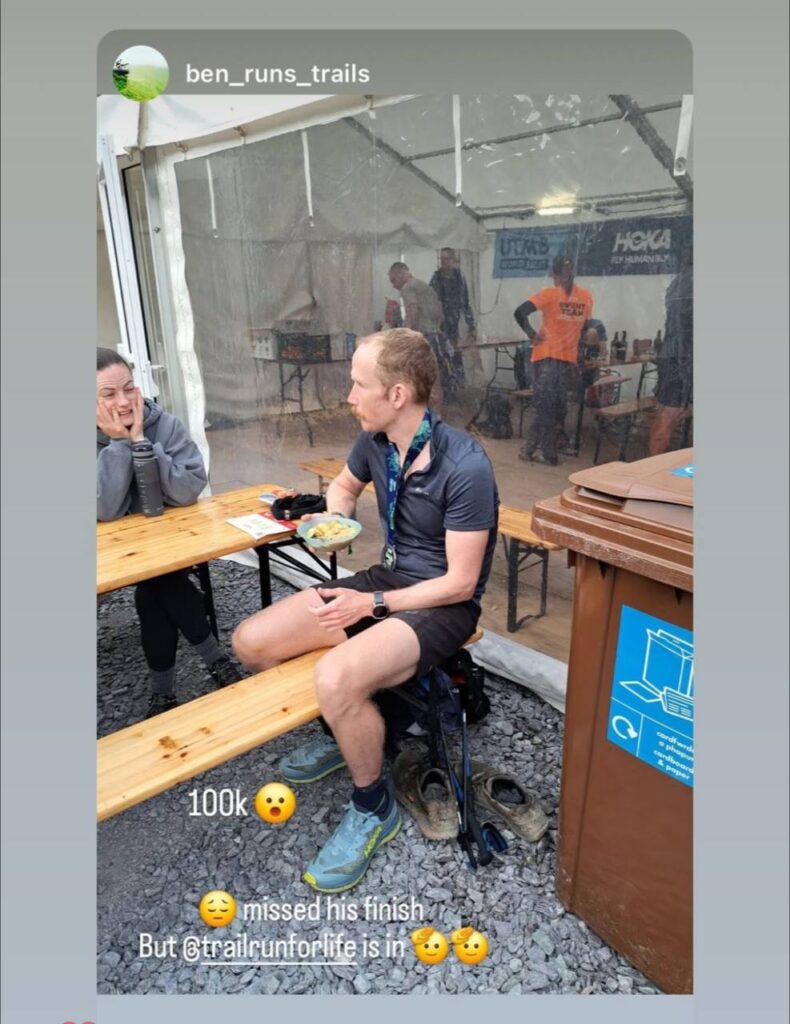

Final thoughts
I went into the event nervous of a niggle in my leg, but it turned out to be a non-issue. Instead, dehydration took me by surprise, forcing me to adapt my strategy in order to ‘survive’ the race.
My learnings from taking on the Dragon’s Back race last year came into play. I’m thankful for those lessons. I was able to temper my pace, slow down, and get control of my dehydration issue before muscle cramping got out of control.
I had aimed for, and was certain I was physically capable of a 21 to 22 hour finish, however with the heat and immense water loss through sweating I experienced, staying on that pace would have had a very high risk of failure, and ultimately could have landed me a DNF. I spent a good three hours or so longer in checkpoints than I needed, and as a result I was able to get to the finish line. Total time out on course was 25 hours, 53 minutes.
At the finish line, I sat down with a hot meal, and was soon greeted by good friends Ben, Cassie, Wilf, Ceri, and George. They had run the 50k event the day before and were staying nearby.
They had tracked me at the top of Moel Eilio, and seen I had an hour or so to go to get to the finish line. Unfortunately they were 5 minutes too late to see me cross the finish line due to my increase in pace in the last 10km. It was still the highlight of my finish to see them there. They were also kind enough to offer me the use of their AirBNB spot’s shower and a bed for a couple of hours nap before I drove home!
- Distance run: 110.20 km
- Elevation climbed: 6,466 m
- Water consumed: At least 16 liters
- Cheese and sweet pickle sandwiches snatched: 14
- Unplanned trail 💩: 2
- Stacked it: 0
My aging Topo athletic Ultraventure Pro shoes held up well. The roomy toebox was brilliant, and I’m happy I didn’t change into brand new Hoka Mafates at the half way point (though they made for excellent finish line shoes!) Using trench cream and sudocrem on my feet worked a treat as usual. My feet were in great shape at the end of the race, no issues there.
Next up in the series, UTS 100 miler?

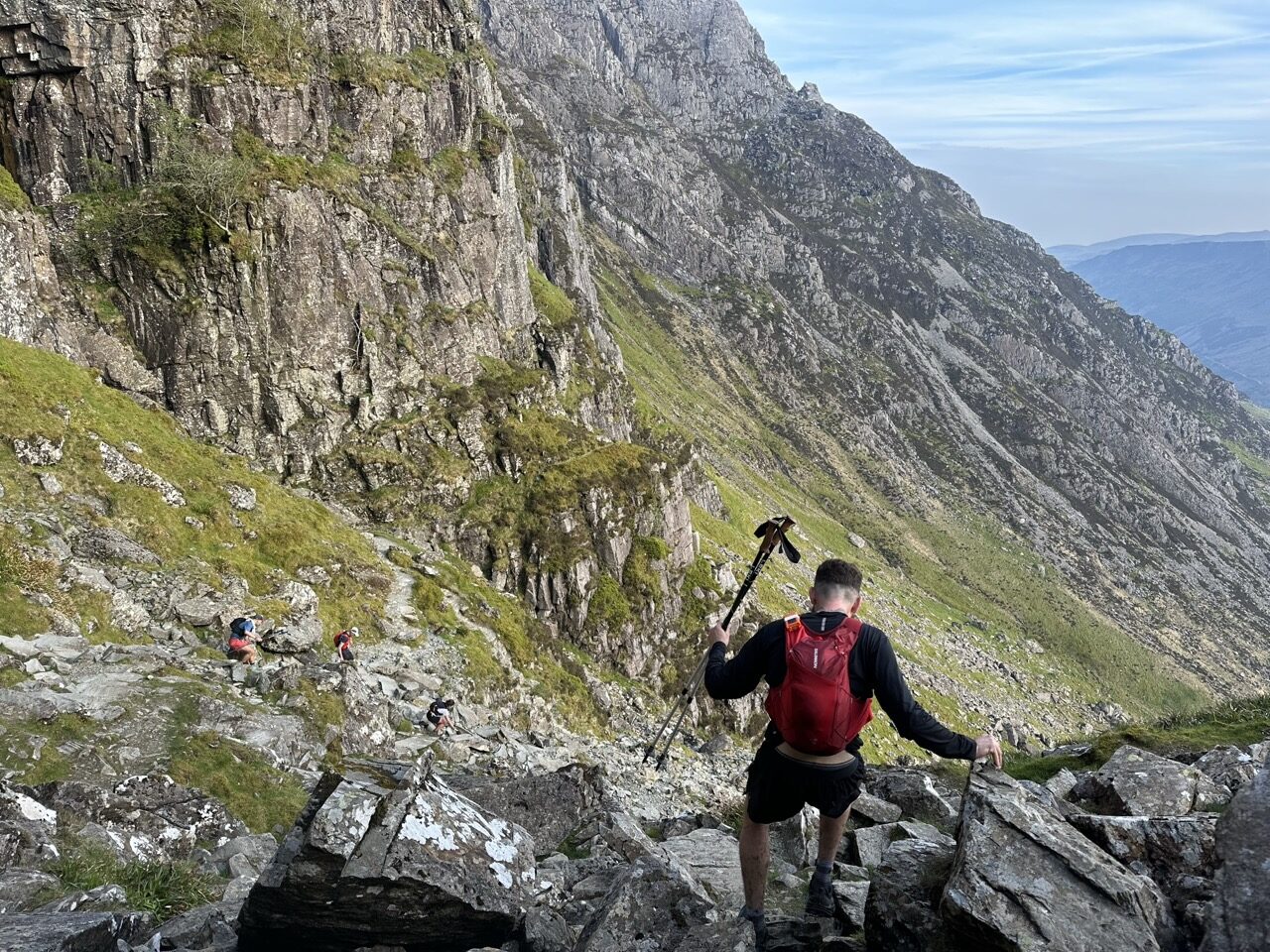
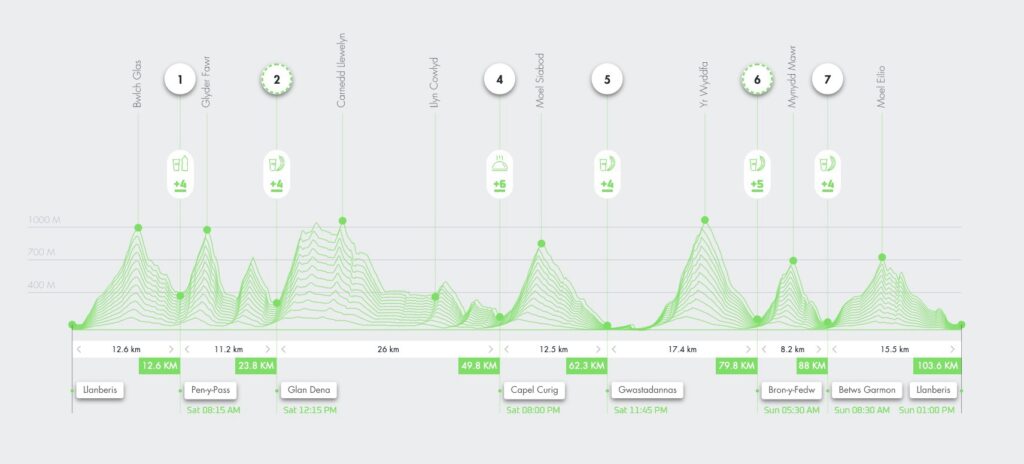






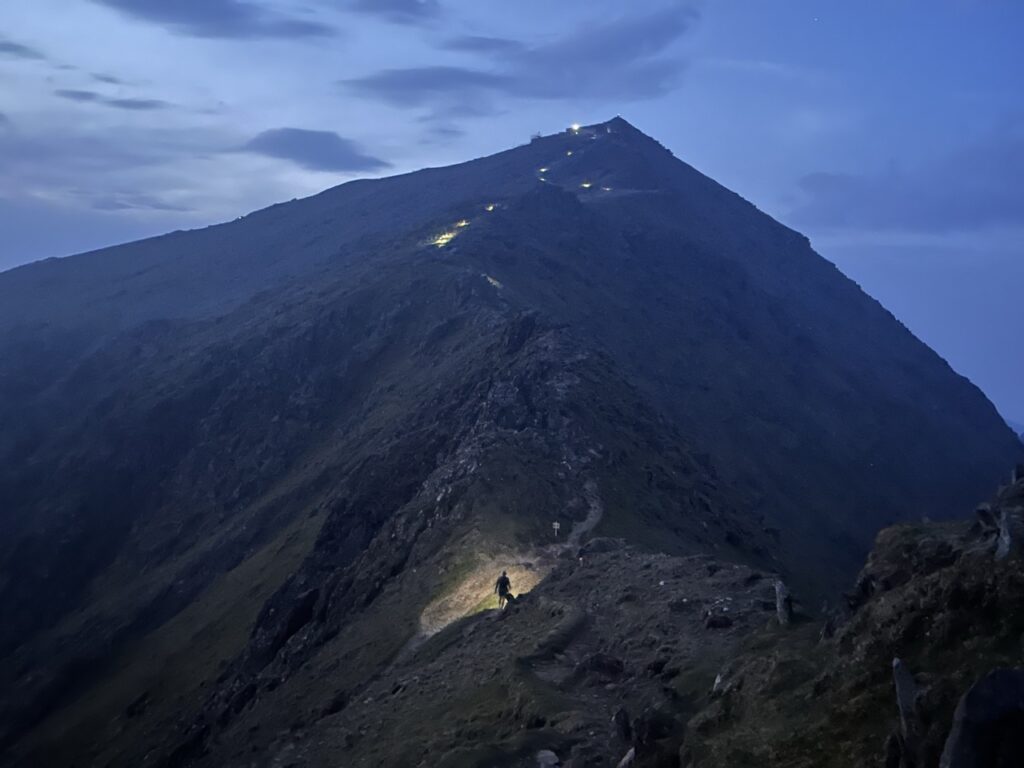


Oh my goodness, resurrection from the dead indeed!!! Congratulations, Sean, on this incredible race!
I had been waiting for this recap and it didn’t disappoint! I reads like a mystery novel – what on earth is going to happen next?
That fast finish was incredible… you can be so proud for finishing so strong. It shows that you really got on top of the hydration game. In that last photo, where you’re sitting on the bench, you look fresh as a daisy!
What helped you the most to stop the cramping? Getting water and electrolytes (yay for crispies and pickle sandwiches!)? Or more the resting part?
And how come the aid stations were so packed? Too many runners on the other distances or bad scheduling of the starting times?
Thank you for this very inspiring recap. And yes, OF COURSE you are doing the UTS 100 miler next time!
A number of people have commented how fresh I looked afterward. I’m not sure how it is hiding, but a few hours after that photo I couldn’t stay awake. I stopped around 6 times for short naps on the side of the road to make sure I could continue driving home safely!
Cramping is such a mystery, but I have personally identified two scenarios where this can happen with my body. Excess muscle fatigue from running hard, and severe water loss / dehydration (or a combination of both I guess). In this case it was the latter – dehydration, I simply needed a lot more water. I was taking plenty of electrolytes throughout the race, but the balance wasn’t there with water.
Aid stations in the first half of the race were packed due to numbers of entries, we didn’t share any of the course in the first half with other race categories, but there were around 700 or so in the 100k. Even with the 15 minute staged start I think there was just a large enough crowd to saturate the checkpoints earlier on. Numbers thinned out after the half way point! Perhaps they could improve by making three waves instead of two next time, or being stricter about keeping support crews out of the aid stations.
The 100 miler for UTS is a big undertaking. I’ll have to consider it later this year after finishing other races first, but it is tempting already.
Congratulations on completing such a challenge!
Can I ask about your shoe choice? You ran UTS50 in the Kjerag, but not for the 100.
I ask as I have the Kjerag and trying to gauge if they’ll work for me for an 85km event this year. I’ve yet to take them to 50km, I’m still getting used to them.
Thanks
Hi Mark,
I chose not use the Kjerag on the 100k for two reasons:
1) I hadn’t tested them on anything longer than 55k, and was slightly concerned over the 100k as they don’t have as much cushion as I’m used to.
2) The 100k has many more ‘boggy, muddy sections’ (basically all the sections between mountains) than the 55k UTS and the Kjerags are much more at home on drier rock, gravel, slate, etc…
Give them a go on a 50-ish km course if you can. I think if you get on well enough over that distance they’ll be great for your 85km event, assuming the terrain fits the shoe!
Good luck!